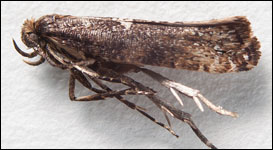Cornell Researchers, Growers Looking for Leek Moth
 Northern New York – The Cornell Cooperative Extension (CCE) associations of Northern New York are asking growers to report any findings of leek moth, a pest that prefers onions, garlic, chives, shallots, leeks and other Allium crops. Cornell University and CCE researchers working with a Northern New York Agricultural Development Program grant to trap the pest to identify its range say that if leek moth becomes established in the major onion production areas of New York, the economic damage could be significant to the $54 million industry.
Northern New York – The Cornell Cooperative Extension (CCE) associations of Northern New York are asking growers to report any findings of leek moth, a pest that prefers onions, garlic, chives, shallots, leeks and other Allium crops. Cornell University and CCE researchers working with a Northern New York Agricultural Development Program grant to trap the pest to identify its range say that if leek moth becomes established in the major onion production areas of New York, the economic damage could be significant to the $54 million industry.
‘The Northern New York Agricultural Development Program grant will help us determine where leek moth is, how fast it is spreading, and will help growers properly time control treatments,’ says Cornell Cooperative Extension of Clinton County Executive Director Amy Ivy, a horticulture specialist.
The farmer-driven Northern New York Agricultural Development Program funds practical, real-world on-farm research, technical assistance and outreach projects to support the productivity and economic viability of farms across New York State’s six northernmost counties.
Dr. Masanori Seto with Cornell University Department of Entomology at the New York State Agricultural Experiment Station in Geneva, NY, says the current distribution of leek moth includes Clinton, Essex, Jefferson and St. Lawrence counties in New York and Grand Isle County in Vermont.
A nocturnal pest, the leek moth adult is rarely seen unless trapped.
Leek moth was first detected in the U.S. in Northern New York in 2009 in garlic and onions in a home garden in Plattsburgh, Clinton County. The pest was identified in St. Lawrence County near Canton in 2010. Additional sites were added in those counties in 2011. Commercial growers in Essex and Jefferson counties reported finding leek moth in their fields in 2012.
The adult leek moth is speckled brown, black and white with a white spot halfway down its outer pair of wings. It has three to four generations a year. The adult survives the winters in northern NY ad become active in the spring. The larva feeds mainly on plant leaves, from inside where they are better protected. It occasionally bores downward into the plant bulb and leaves feeding damage.
Leek moth damage stunts plant growth, introduces rot, compromises the storage life of onions and garlic, and negatively impacts the marketability of the crops.
Cornell University entomologist Dr. A. M. Shelton is evaluating insecticidal treatments in his Ithaca campus lab. He is developing a growing day-degree model to help growers target optimal insecticide application timing.
As part of the NNYADP-funded grant, Dr. Shelton is also investigating opportunities to use biological control agents effective in controlling leek moth.
‘Eradication is not realistic, so we are learning to properly time treatments to reduce leek moth populations and the associated crop damage,’ Ivy says.
Two insecticidal products are currently approved for use on organic crops; three for use in conventional production.
Ivy encourages growers to implement the cultural practices currently available to growers to prevent leek moth infestation. Those practices include the use of row covers immediately after planting to prevent adults from laying eggs on host crops, crop rotation, delayed planting, good field and harvest hygiene, scouting and destruction of leek moth pupae or larvae, and early harvesting before the final seasonal flight occurs.
Leek moth, native to Europe, was first discovered in North America in Ontario, Canada, in 1993. Leek moth is able to overwinter in the northern climate. The damage done by leek moth can resemble that caused by thrips, snails, salt marsh caterpillars, and Botrytis leaf blight.
Leek moth has also been found in Allium crops in Vermont. Ivy and Seto have met with horticulturists at the University of Vermont to develop an information exchange to keep educators and growers in both states current with leek moth sightings.
A Cornell Cooperative Extension Fact Sheet on Leek Moth is available at local CCE offices and online athttp://web.entomology.cornell.edu/shelton/leek-moth/images/RESOURCES/factsheet2011.pdf.
More information on leek moth is available at www.nnyagdev.org under Horticulture and through the Leek Moth Information Center for the U.S. at Cornell University: http://web.entomology.cornell.edu/shelton/leek-moth/.
Posted: August 30th, 2013 under Agricultural News, Business News, Education News, Environmental News, General News, Northern NY News.
